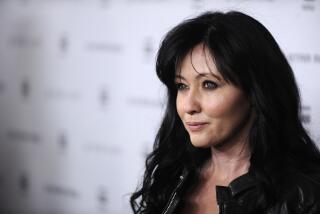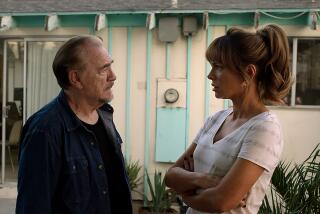Bad to the Roots
- Share via
Who’s afraid of the big bad blond? Lots of people, apparently. The sun goddess in all her flaxen glory--acquisitive, seductive, with a heart of ice--has become a virtual stock villain of late, particularly in kids’ films but in other kinds of movies as well.
As the most recent example, the Disney remake of “The Parent Trap,” which opened Wednesday, shows, there’s usually a simple antidote to vicious Sister Goldenhair: the ingenuity of children. The twins in “Parent Trap,” after all, foil the best-laid plans of the film’s central antagonist, a publicist named Meredith who plans to marry their father. Adorability (kids) trumps ambition (the blond) every time.
Meredith (played with a delightful, cunning charm by Elaine Hendrix) is the prototype for the conniving blond, who views all of life as an offshoot of her own existence and love as a chance to better her position in the world.
But even as she tries to lure vineyard owner Nick Parker (Dennis Quaid) into nuptial bondage, Meredith is foiled by Nick’s adoring twin daughters, both played by Lindsay Lohan.
Hendrix says she can understand her character’s motivation, even if it’s somewhat twisted.
“Really, Meredith starts with the intention of trying to win the little girl over,” Hendrix says. “Little by little, she learns that she’s got her work cut out for her, in the form of an 11-year-old girl--or girls.
“When I was 11, my dad did get remarried,” Hendrix adds. “I remember jealous feelings, not wanting Dad to get married. But I was lucky: He didn’t marry Cruella DeVil and I didn’t have to resort to pranks.”
Hendrix bristles at the notion that blonds have become synonymous with cartoonish villainy, though she doesn’t deny that it’s not uncommon in movies. Part of the reason, she says, is that it has become more acceptable for women to play villains.
“It’s almost as if we’re going back to the Adam and Eve story,” says Hendrix, who was also seen as a snooty blond (though one who later revealed actual niceness) in “Romy and Michele’s High School Reunion.” “When you look at the collective consciousness and the various personas that story is identified with, you often wind up with Eve as the seductress who lured Adam into eating the apple.
“Throughout history, women have been categorized into either Eve roles or Virgin Mary roles. They’re the extremities of the stereotypes. I don’t know if people feel safer believing those things, but these are the roles women have had to fit into. Certainly it’s time for a change.”
Not that Hendrix minded playing those negative traits as the blond Meredith: “I think she’s the shadow aspect of us all,” she says. “I know I don’t get too many chances to go around being so relentlessly mean and detestable. Or if I get them, I don’t take them. When I played her, I thought of her as someone who knows what she wants and how to get it. And she has no thoughts about the possible problems of doing so. She just wants what she wants.”
The image of the blond has shifted drastically since the beginning of movies. In the days of Mary Pickford, the blond was virginal, upright, resourceful. Mae West and Jean Harlow pushed it to the opposite extreme: sexy, brassy, aggressive. Marilyn Monroe came down somewhere in the middle: seductive but vulnerable, the little girl in the woman’s body, a role that’s been used in one form or another by actresses ranging from Jayne Mansfield to Madonna.
It’s all been refined, Hendrix says, to two basic roles for blonds: “You’re either stereotyped into the ditsy role or the role of the seductress. I lean toward the seductress. But ditsy roles are fun too.
“I don’t know if it’s the hair color or what. There are so many types of roles women do that it’s a shame to try to stereotype women based on their looks. I certainly don’t want to perpetuate the stereotype. Ten years down the road, I want to see a whole array of things available to me.”
More to Read
Only good movies
Get the Indie Focus newsletter, Mark Olsen's weekly guide to the world of cinema.
You may occasionally receive promotional content from the Los Angeles Times.










